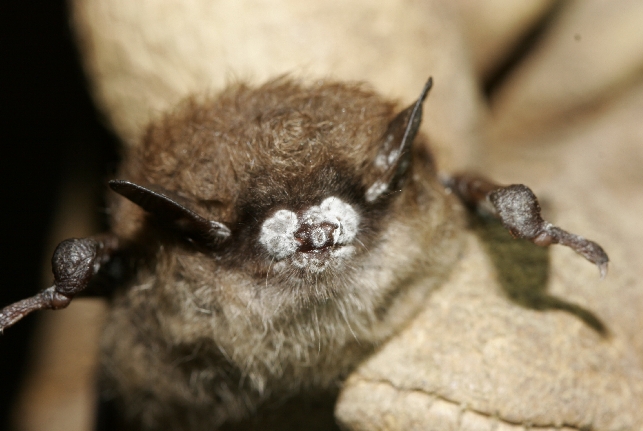| Description | Participants | Agenda | Summary | Products | Feature Article |
|---|
Unraveling the Mystery of White-Nose Syndrome in Bats
May 8, 2009
 |
| Photo courtesy Ryan von Linden/New York Department of Environmental Conservation |
The mysterious disease that has killed more than 90 percent of wintering bats in some caves and mines from Vermont to Virginia during the past three years has raised numerous questions about the nature of the disease and how to control it.
Leading experts in the fields of bat physiology, fungal ecology, ecotoxicology, disease and environmental modeling, among others, gathered at a workshop at The National Institute for Mathematical and Biological Synthesis (NIMBioS), June 29-July 1, in Knoxville, Tenn., to explore the disease and to develop solutions to manage it. Representatives from relevant state and federal agencies and other organizations attended.
The affliction has been given the name "White-Nose Syndrome" (WNS) due to its distinctive white fungus growing on the muzzles and other body parts of infected bats. More than a half million bats have died in the past three years due to the disease. Although the cause is unknown, the pathogen is most likely a cold climate fungus. Scientists do not know if the fungus is the sole cause of the bat deaths, or if it is merely an opportunistic pathogen, taking advantage of immune systems weakened by another biological or chemical agent.
It is unclear how WNS spreads, but it is likely transmitted from bat to bat. Other evidence suggests that humans transport the fungus from infected sites to clean sites on clothing and equipment.
The purpose of the meeting was to determine the present knowledge of the disease and to develop predictive models to determine how and under what conditions the disease might spread. Ultimately, the models would be used to help devise appropriate management strategies for controlling it.
Tom Hallam, workshop co-organizer and professor of ecology and evolutionary biology at the University of Tennessee, said so far two management strategies have been proposed to contain the spread of the disease. The first is to eliminate human activity in the caves, which has already been implemented in the eastern U. S. The second proposed management scheme involves heating portions of cave hibernacula to help conserve the bats’ energy reserves during arousals from hibernation so as to discourage the bats from leaving the cave to look for food before the spring. The disease disturbs the bats’ hibernation patterns, thus causing the bat to become severely underweight.
"However, neither of these strategies has been seriously looked at from a scientific point-of-view," Hallam said.
Gary McCracken, workshop co-organizer and professor of ecology and evolutionary biology at the University of Tennessee, said that some bats appear to have a resistance to the disease and that native bats in Europe appear to be immune to it. Both aspects need further investigation, he said.
"It does not kill all species. In affected species, roughly 5-10 percent survive, which is a viable survival rate. Given that there is evidence of resistance to the fungus and that it is not pathogenic to native bats in Europe, the potential exists that its spread is self-limiting," McCracken said.
Eating up to two-thirds of their body weight in insects over night, bats help keep insects under control, ultimately reducing the quantities of insecticides used on crops. Bats also play an important ecological role in plant pollination and seed dissemination.
In April, the U.S. Forest Service issued an emergency order to close caves and mines in 33 states for up to one year, while scientists work toward learning more about the disease. In 2009, WNS spread south from New England into West Virginia and Virginia and now threatens to spread to the Midwest and Southeast. The Great Smoky Mountains National Park has also closed all its caves to the public, although evidence of the fungus has not been found in the park.
Modeling WNS in Bats at the Individual and Colony Levels: Epizootiology and Management was a NIMBioS Investigative Workshop. NIMBioS Investigative Workshops involve up to 35 participants, of which about half are invited. Individuals with a strong interest in the topic can also apply to attend.
The National Institute for Mathematical and Biological Synthesis (NIMBioS) brings together researchers from around the world to collaborate across disciplinary boundaries to investigate solutions to basic and applied problems in the life sciences. NIMBioS is funded by the National Science Foundation in collaboration with the U.S. Department of Homeland Security and the U.S. Department of Agriculture, with additional support from The University of Tennessee, Knoxville.
For more information, contact Catherine Crawley at 865-974-9350 or ccrawley@nimbios.org
NIMBioS
1122 Volunteer Blvd., Suite 106
University of Tennessee
Knoxville,
TN 37996-3410
PH: (865) 974-9334
FAX: (865) 974-9461
Contact NIMBioS


